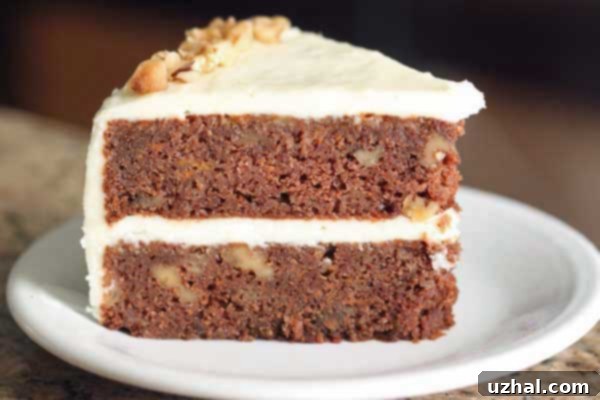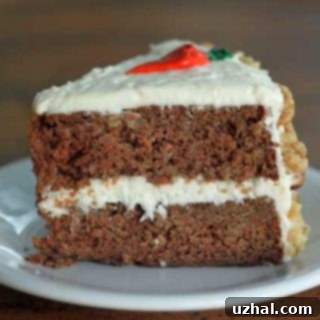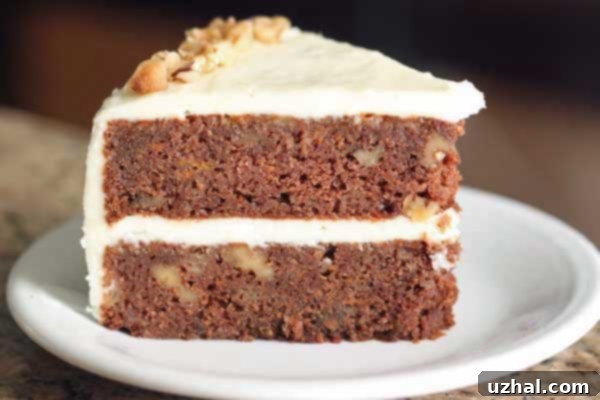The Ultimate Guide to Chocolate Carrot Cake: A Delightful Fusion of Flavors
For many, the idea of combining two beloved classics – the rich, earthy goodness of carrot cake and the decadent allure of chocolate cake – might seem, at first glance, counterintuitive. I certainly felt that way. Why tamper with the comforting familiarity of a traditional carrot cake, known for its moist crumb and warm spices, by introducing chocolate? Or, conversely, why detract from the pure indulgence of a chocolate cake with the addition of carrots? My initial misgivings were strong, but a persistent curiosity (and perhaps a touch of baking bravery) eventually led me to try a recipe that promised to bridge these two delicious worlds: the chocolate carrot cake.

Unveiling the Mrs. Fields Chocolate Carrot Cake
My journey into the realm of chocolate carrot cake began with an old, trusted Mrs. Fields recipe. Known for her iconic cookies, Mrs. Fields also had a take on this intriguing dessert, crafted with the usual comforting proportions expected from a classic carrot cake. The key deviation, however, was the inclusion of a half cup of unsweetened cocoa powder, replacing some of the traditional spices. In her introduction, Mrs. Fields made a crucial promise: the cocoa would not be overpowering, and the cake would retain the moist, tender crumb that defines a truly good carrot cake. This assurance was particularly reassuring for me, as my primary motivation for venturing into this recipe wasn’t necessarily for an intense chocolate flavor. Instead, I had developed a fascination with achieving a deep brown hue in carrot cakes – a stark contrast to the often vibrantly orange versions – and wondered if cocoa held the secret.
Upon baking and tasting, the results were delightful and confirmed Mrs. Fields’ promise. The cake emerged from the oven with precisely the right shade of rich, earthy brown I had been seeking. More importantly, the chocolate flavor was remarkably subtle, acting less as a dominant note and more as a sophisticated undertone that enhanced the overall profile. It wasn’t a chocolate cake with carrots, nor was it a traditional carrot cake with an added chocolate layer. It was a harmonious blend where the cocoa provided a depth of color and a nuanced flavor that complemented the sweetness of the carrots and the warmth of the accompanying spices (even if less pronounced in this particular recipe). This experience led me to ponder if cocoa powder might indeed be the hidden ingredient behind the dark, alluring carrot cakes often served in high-end restaurants. If a third to a half cup yields such a subtle taste, a smaller amount could potentially achieve that coveted deep brown color with almost no discernible chocolate flavor, simply enriching the cake’s appearance.
This initial success has sparked a new determination in my baking adventures: to explore more carrot cakes that incorporate cocoa powder. Following the Mrs. Fields experiment, I stumbled upon Chef Scott Peacock’s recipe, which intriguing uses just a single tablespoon of cocoa powder alongside a full tablespoon of cinnamon. This variation suggests an even more subtle approach to using cocoa for color and depth. As much as my family and I adored the Mrs. Fields version, the scientific baker in me feels compelled to try the 1-tablespoon cocoa version for a direct comparison. This ongoing quest is not just about finding the “best” recipe, but understanding the intricate ways ingredients interact to create texture, flavor, and visual appeal in our beloved baked goods.
The Quest for Dark Brown Carrot Cakes: Beyond Chocolate – The Divorce Cake
While cocoa powder proved to be an excellent tool for achieving a rich brown color in carrot cakes, my pursuit of the perfect dark hue didn’t stop there. In my ongoing quest, I discovered another fascinating method: the “Divorce Cake.” This unique carrot cake derives its name from a whimsical, yet practical, tradition where bakers would often divide the cake – half for one person, half for another, perhaps symbolizing a humorous take on marital disagreements, or simply the cake being so good it could cause a fight over the last slice! The Divorce Cake recipe was exactly what I had been searching for in terms of color, but through an entirely different mechanism. Instead of cocoa, this cake incorporates honey, and its interaction with baking soda contributes significantly to its beautifully deep brown shade.
The science behind this is quite interesting. Honey, being slightly acidic, when combined with alkaline baking soda and subjected to heat, undergoes a browning reaction (Maillard reaction and caramelization) more readily than cakes made with granulated sugar alone. This chemical reaction not only imparts a distinctive, rich flavor but also yields that desirable dark brown color without relying on chocolate. The Divorce Cake proved to be an exceptional alternative for those who desire a darker carrot cake without any chocolate notes whatsoever. This discovery broadened my understanding of how different ingredients can influence the final appearance and flavor of a cake, adding another dimension to the art and science of baking.
Exploring both the Mrs. Fields Chocolate Carrot Cake and the Divorce Cake has been an enlightening journey. It highlights that there isn’t just one path to a perfect, deeply colored carrot cake. Whether you prefer a subtle hint of chocolate or the unique caramel notes of honey, understanding the role of ingredients like cocoa powder, baking soda, and honey allows for creative control over your baking outcomes. It’s about tailoring the cake to your exact preference, both in taste and visual appeal.
Why Chocolate Carrot Cake? A Delicious Harmony
Having navigated through my initial skepticism, I’ve come to appreciate the chocolate carrot cake not just as a novelty, but as a genuinely delightful dessert that offers a unique culinary experience. But what exactly makes this fusion so appealing?
- Harmonious Flavor Profile: The beauty of chocolate carrot cake lies in the unexpected yet complementary interplay of flavors. The earthiness and subtle sweetness of carrots, often enhanced by warm spices like cinnamon and nutmeg, find a perfect partner in cocoa. The cocoa adds a layer of depth and a slight bitterness that beautifully balances the sweetness, creating a more complex and sophisticated taste that neither cake achieves on its own.
- Enhanced Moisture and Texture: Carrots are naturally rich in moisture, which is a hallmark of a great carrot cake. Cocoa powder, especially natural unsweetened cocoa, can also contribute to a tender, moist crumb by absorbing some of the liquid and fats, preventing the cake from becoming overly dense or dry. The Mrs. Fields recipe, in particular, uses butter instead of oil, resulting in a cake that is exceptionally moist without being greasy, a texture often preferred by many bakers.
- Striking Visual Appeal: Let’s face it, a darker cake just looks more decadent. The deep brown hue imparted by cocoa powder gives the carrot cake a rich, luxurious appearance, setting it apart from its brighter, more orange counterparts. This visual appeal can elevate the dessert, making it feel more special and indulgent.
- A Unique Twist on a Classic: For those who love both carrot cake and chocolate cake but are looking for something a little different, this fusion offers the best of both worlds without being overly complicated. It’s a creative way to reimagine familiar flavors and surprise your taste buds.
- Versatility in Flavor Intensity: One of the greatest advantages is its adaptability. As my experiments showed, the amount of cocoa powder can be adjusted to achieve various levels of chocolate intensity. From a very subtle hint that mainly contributes color, to a more pronounced chocolate flavor that still allows the carrot notes to shine through, bakers can customize the cake to their personal preference.
Baking Science: The Magic of Cocoa, Carrots, and Moisture
Understanding the science behind baking chocolate carrot cake can help in achieving consistent, delicious results. Each ingredient plays a crucial role:
- Cocoa Powder: Natural unsweetened cocoa powder is slightly acidic, and when combined with baking soda (an alkali) and moisture, it contributes to the cake’s lift and tenderness. Dutch-processed cocoa, on the other hand, is neutral or slightly alkaline, so it reacts better with baking powder. The choice can affect both the color and the rise. In the Mrs. Fields recipe, using natural cocoa with both baking powder and baking soda helps achieve a balanced texture and a rich brown color.
- Carrots: Beyond their sweet flavor, grated carrots are a powerhouse of moisture. They slowly release their water content during baking, ensuring a consistently moist crumb. The finer the grate, the more moisture they release and the more seamlessly they integrate into the batter.
- Pineapple: The small can of crushed pineapple, used undrained in the Mrs. Fields recipe, is a secret weapon for ultimate moisture, texture, and a bright, tangy flavor. The acidity in pineapple also interacts with baking soda, aiding in leavening and further contributing to tenderness.
- Butter vs. Oil: While many traditional carrot cakes use oil for moisture (as oil stays liquid at room temperature), the Mrs. Fields recipe calls for melted butter. Butter contributes a richer flavor and a slightly denser, more cake-like crumb compared to the lighter, airier texture achieved with oil. The melted butter also helps distribute fat evenly, contributing to the cake’s non-greasy, moist consistency mentioned in the recipe summary.
- Spices: Even with cocoa, the traditional spices like cinnamon (which I added in a test) play a vital role. They provide warmth and complexity. However, as noted, cocoa can mute some spice flavors, so adjusting quantities might be necessary if a strong spice presence is desired.
- Mrs. Fields Cinnamon Sugar Butter Cookies
- Mrs. Fields’ White Chocolate Bundt Cake
- Chocolate Carrot Brownies
- Best Carrot Cupcakes
- Carrot Walnut Muffins
Recipe: Mrs. Fields-Inspired Chocolate Carrot Cake

Chocolate Carrot Cake
Cookie Madness
Pin Recipe
Ingredients
- 2 cups all-purpose flour (approx. 10 oz)
- 2 cups granulated or raw sugar (approx. 14 oz)
- 1 teaspoon salt
- 1 teaspoon baking powder
- 1 teaspoon baking soda
- ⅓ to ½ cup unsweetened natural cocoa powder
- 4 large eggs
- 3 sticks (12 oz) unsalted butter, melted and cooled
- 1 tablespoon vanilla extract
- 1 small can crushed pineapple in juice (undrained, typically 8 oz or 227g)
- 2 cups grated carrots (about 3-4 medium carrots)
- ⅔ cup toasted walnuts (optional, but adds great crunch)
Cream Cheese Frosting
- 16 oz cream cheese (full-fat, softened)
- 4 oz (1 stick) unsalted butter, softened
- 2-3 cups powdered sugar (sifted, plus more if desired for sweetness/thickness)
- 1 teaspoon vanilla extract
- ½ cup sweetened flaked coconut (optional, but adds tropical flavor and texture)
Instructions
-
Prepare for Baking: Preheat your oven to a steady 350 degrees Fahrenheit (175 degrees Celsius). Lightly grease and flour two 9×2 inch round cake pans, ensuring the flour coats evenly to prevent sticking.
-
Combine Dry Ingredients: In a large mixing bowl, thoroughly whisk together the all-purpose flour, granulated or raw sugar, salt, baking powder, baking soda, and unsweetened natural cocoa powder. Ensure there are no lumps and the cocoa is fully incorporated for even flavor and color distribution.
-
Prepare Wet Ingredients: In a separate mixing bowl, beat the large eggs with an electric mixer until they become light and foamy. Gradually, pour in the melted and cooled unsalted butter, followed by the vanilla extract, beating until well combined.
-
Combine and Add Add-ins: Using a large rubber scraper or spatula, gradually fold the dry flour mixture into the wet egg mixture. Mix just until the flour streaks disappear – be careful not to overmix, as this can lead to a tough cake. Once the batter is cohesive, gently stir in the grated carrots and the entire can of crushed pineapple (undrained, for maximum moisture). If you’re using them, fold in the toasted walnuts at this stage.
-
Bake the Cakes: Divide the cake batter evenly between the two prepared cake pans. Bake in the preheated oven for approximately 30-35 minutes, or until the tops are beautifully browned, and a wooden skewer or toothpick inserted into the center comes out clean. The cake should also spring back lightly when touched. Allow the cakes to cool in the pans for about 10-15 minutes before carefully inverting them onto a wire rack to cool completely.
-
Prepare the Cream Cheese Frosting: To make the luscious cream cheese frosting, beat the softened cream cheese and softened unsalted butter together in a mixing bowl with an electric mixer until the mixture is wonderfully creamy and smooth. Gradually add the powdered sugar, one cup at a time, beating well after each addition and scraping down the sides of the bowl frequently. Beat in the vanilla extract. Taste test the frosting, and if you prefer it sweeter or thicker, you can gradually add more powdered sugar until it reaches your desired consistency and sweetness. If desired, gently fold in the sweetened flaked coconut.
-
Frosting Tip (Optional): For an extra layer of flavor and texture, I often like to mix the coconut into only a portion of the frosting. This coconut-infused frosting can then be used specifically for the center layer of the cake, offering a delightful surprise with every slice.
-
Assemble and Serve: Once the cake layers are completely cooled, evenly spread the prepared cream cheese icing between the layers and over the top and sides of the cake. For best results, chill the frosted cake for at least 30 minutes before serving, allowing the frosting to set. Enjoy this exquisite chocolate carrot cake!
Notes
Conclusion: Embracing the Delightful Fusion
My journey from a skeptic to an ardent admirer of chocolate carrot cake has been a delicious revelation. What began as a mere curiosity, driven by a desire for a deeper brown hue in my carrot cakes, transformed into an appreciation for a truly unique and harmonious dessert. The subtle infusion of cocoa powder, as perfected in the Mrs. Fields recipe, adds an unexpected layer of depth and visual appeal without overshadowing the beloved characteristics of a classic carrot cake. Furthermore, the exploration of alternatives like the “Divorce Cake” highlighted the diverse avenues available to bakers for achieving specific aesthetic and flavor profiles.
This experience has not only expanded my baking repertoire but also reinforced the idea that sometimes, the most surprising combinations yield the most rewarding results. Chocolate carrot cake is more than just a blend of two popular desserts; it’s a testament to how seemingly disparate flavors can unite to create something entirely new and wonderfully satisfying. I encourage you to set aside any initial reservations and embark on your own chocolate carrot cake adventure. Whether you’re seeking a subtle chocolate undertone, a darker aesthetic, or simply a remarkably moist and flavorful cake, this recipe offers a delightful experience that truly captures the best of both worlds. It might just become your new favorite dessert, proving that some culinary fusions are simply meant to be.
